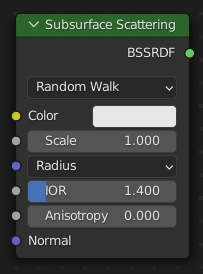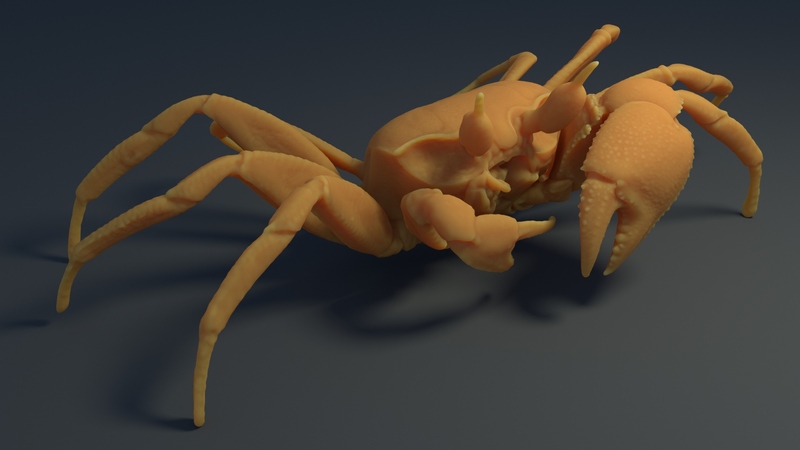Subsurface Scattering – Підповерхневе Розсіювання

The Subsurface Scattering node is used to add simple subsurface multiple scattering, for materials such as skin, wax, marble, milk and others. For these materials, rather than light being reflect directly off the surface, it will penetrate the surface and bounce around internally before getting absorbed or leaving the surface at a nearby point.
How far the color scatters on average can be configured per RGB color channel. For example, for skin, red colors scatter further, which gives distinctive red-colored shadows, and a soft appearance.
Inputs – Уводи
- Color – Колір
Колір поверхні, або фізично кажучи, ймовірність того, що світло відбивається для кожної довжини хвилі.
- Scale – Масштаб
Фактор глобального масштабу для радіуса розсіювання.
- Radius – Радіус
Average distance that light scatters below the surface. Higher radius gives a softer appearance, as light bleeds into shadows and through the object. The scattering distance is specified separately for the RGB channels, to render materials such as skin where red light scatters deeper. The X, Y and Z values are mapped to the R, G and B values, respectively.
- IOR Cycles Only
Index of refraction for Subsurface Scattering.
- Anisotropy Cycles Only
Controls the directionality of subsurface scattering.
- Normal – Нормаль
Нормаль, використовувана для відтінювання; якщо нічого до цього уводу не під’єднано, то використовується стандартна нормаль відтінювання.
Properties – Властивості
- Метод Підповерхневе – Subsurface Method
Метод рендерингу для симулювання підповерхневого розсіювання.
Примітка
EEVEE does not support the Random Walk methods.
- Крістенсен-Берлі – Christensen-Burley:
An approximation to physically-based volume scattering. This method is less accurate than Random Walk however, in some situations this method will resolve noise faster.
- Random Walk (Fixed Radius):
Provides accurate results for thin and curved objects. Random Walk uses true volumetric scattering inside the mesh, which means that it works best for closed meshes. Overlapping faces and holes in the mesh can cause problems.
- Випадковий Хід – Random Walk:
Behaves similarly to Random Walk (Fixed Radius) but modulates the Radius based on the Color, Anisotropy, and IOR. This method thereby attempts to retain greater surface detail and color than Random Walk (Fixed Radius).
Outputs – Виводи
- BSSRDF
BSSRDF shader output.
Examples – Приклади

Random walk subsurface scattering.